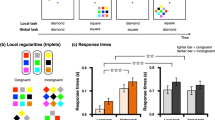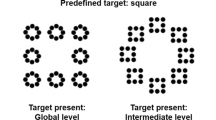Abstract
THE perceptual world is organized hierarchically: the forest consists of trees, which in turn have leaves. Visual attention can emphasize the overall picture (global form) or the focal details of a scene (local components)1. Neuropsychological studies have indicated that the left hemisphere is biased towards local and the right towards global processing. The underlying attentional and perceptual mechanisms are maximally impaired by unilateral lesions to the temporal and parietal cortex2,3. We measured brain activity of normal subjects during two experiments using 'hierarchically' organized figures. In a directed attention task, early visual processing (prestriate) areas were activated: attention to the global aspect of the figures activated the right lingual gyrus whereas locally directed attention activated the left inferior occipital cortex. In a subsequent divided attention task, the number of target switches from local to global (and vice versa) covaried with temporal–parietal activation. The findings provide direct evidence for hemispheric specialization in global and local perception; furthermore, they indicate that temporal–parietal areas exert attentional control over the neural transformations occurring in prestriate cortex.
Similar content being viewed by others
References
Navon, D. Cogn. Psychol. 9, 353–383 (1977).
Robertson, L. C., Lamb, M. R. & Knight, R. T. J. Neurosci. 8, 3757–3769 (1988).
Marshall, J. C. & Halligan, P. W. Nature 373, 521–523 (1995).
Hellige, J. B. Hemispheric Asymmetry: What's Right and What's Left (Harvard Univ. Press, Cambridge, MA, 1993).
Robertson, L. C. & Lamb, M. R. Cogn. Psychol. 23, 299–330 (1991).
Heinze, H. J. et al. Nature 372, 543–546 (1994).
Corbetta, M., Miezin, F. M., Dobmeyer, S., Shulman, G. L. & Petersen, S. E. Science 248, 1556–1559 (1990).
Motter, B. C. J. Neurophysiol. 70, 909–919 (1993).
Clarke, S. Eur. J. Neurosci. 6, 725–736 (1994).
Shipp, S., Watson, J. D. G., Frackowiak, R. S. J. & Zeki, S. Neuroimage 2, 125–132 (1995).
Sereno, M. I. et al. Science 268, 889–893 (1995).
Moran, J. & Desimone, R. Science 229, 782–784 (1985).
Polster, M. R. & Rapcsak, S. Z. Cortex 30, 487–497 (1994).
Rafal, R. & Robertson, L. C. in The Cognitive Neurosciences (ed. Gazzaniga, M. S.) 625–647 (MIT Press, London, 1995).
Talairach, J. & Toumoux, P. Coplanar Stereotaxic Atlas of the Human Brain (Thieme, Stuttgart, 1988).
Tipper, S. P., Weaver, B. & Houghton, G. Q. J. Exp. Psychol. A 47, 809–840 (1994).
Silbersweig, D. A. et al. J. Cereb. Blood Flow Metab. 13, 617–629 (1993).
Friston, K. J. et al. Hum. Brain Map. 2, 1–25 (1995).
Friston, K. J. et al. Hum. Brain Map. 2, 189–210 (1995).
Author information
Authors and Affiliations
Rights and permissions
About this article
Cite this article
Fink, G., Halligan, P., Marshall, J. et al. Where in the brain does visual attention select the forest and the trees?. Nature 382, 626–628 (1996). https://doi.org/10.1038/382626a0
Received:
Accepted:
Issue Date:
DOI: https://doi.org/10.1038/382626a0
- Springer Nature Limited
This article is cited by
-
The Stroop effect involves an excitatory–inhibitory fronto-cerebellar loop
Nature Communications (2023)
-
Brain structural and functional anomalies associated with simultanagnosia in patients with posterior cortical atrophy
Brain Imaging and Behavior (2022)
-
The lateral intraparietal sulcus takes viewpoint changes into account during memory-guided attention in natural scenes
Brain Structure and Function (2021)
-
Rapid acquisition of novel written word-forms: ERP evidence
Behavioral and Brain Functions (2020)
-
Neural correlates of conceptual-level fear generalization in posttraumatic stress disorder
Neuropsychopharmacology (2020)





